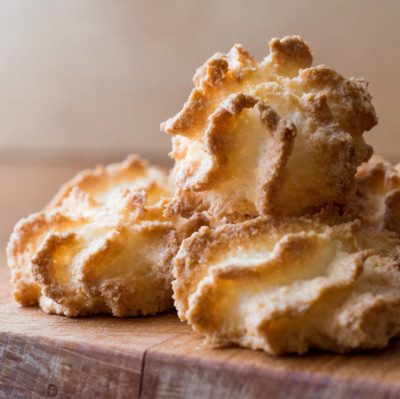Origin
Macaroons are said to have originated in Italy, particularly Venice, during the Renaissance. The name is derived from the Italian maccherone and the venetian macarone, meaning a fine paste, from which the word macaroni is also derived.1,3 In the U.S., coconut macaroon variations are more popular while the almond macaroon variations are more popular in Italy, France and other parts of Europe.2
They first appeared in Italian monasteries as early as 791 and legend has it that they used to be made in the shape of monks’ navels. These early versions were most likely a crunchy cookie with a soft interior made from almond paste, egg whites, and sugar. The recipes for macaroons spread slowly, with the first accounts occurring in France in 1533. The first recipes for these treats were not recorded until 1725.1
How are macaroons made?
Macaroons are quite simple to prepare. Most recipes involve foaming egg whites and sugar to the desired stage and then folding in the inclusions before depositing and baking the batter.
The following formulas demonstrate the process for preparing coconut-based macaroons:
| Coconut macaroon | |
| Ingredient | Baker’s % (based on sugar) |
| Coconut* | 93.0 |
| Granulated sugar | 37.0 |
| Egg whites | 60.0 |
* Macaroon coconut is finely ground or flaked, unsweetened, dried coconut.
Processing specifications
- Mix all the ingredients in a mixer and stir continuously. Heat mixture while mixing to reach a final temperature of 131°F (55°C)
- Deposit the mixture onto parchment lined sheet pans approximately 2 inches (5.0 cm) in diameter and 1.8 inches (4.5 cm) in height
- Bake at 326°F (163°C) in a convection oven until golden brown, approximately 15 minutes
- When cool, the bottoms may be dipped in tempered chocolate and set before packaging
Application
There are hundreds of variations of macaroons throughout the world. Every region has adopted its own style or formula. Some popular inclusions are chocolate and coconut, which is common throughout Europe, North America, and Australia. In India cashews are often used.
The Spanish type is made with hazelnuts and honey often added to the recipe. All these variations have led to an inconsistently defined product. For example, in the United States, macaroons are dense and chewy, while in France, they are light and airy, and often made without coconut.
Relevant considerations when making macaroons:
- Ingredients such as cream of tartar or other acidulates may be added to increase processing tolerance and stability of the egg foam.
- Care should be taken that the eggs are at room temperature for ideal development and incorporation of air cells in the batter.
- All equipment coming in contact with the egg whites should be completely free of water as water will disrupt the foam.
- Equipment-product contact surfaces can be rinsed with vinegar to remove any possible fat contaminants.
References
- Jones, Bridget, and Robuchon Joël. “Macaroon.” New Concise Larousse Gastronomique: the Culinary Classic Revised and Updated, Hamlyn, 2007, p. 700.
- Gisslen, W. “Cookies” Professional Baking, 7th edition, John Wiley & Sons, Inc., Hoboken, New Jersey, 2017, pp. 483–517.
- Suas, M. “Cookies” Advanced Bread and Pastry: A Professional Approach, first printing, Delmar, Cengage Learning, 2009, pp. 400–441.

